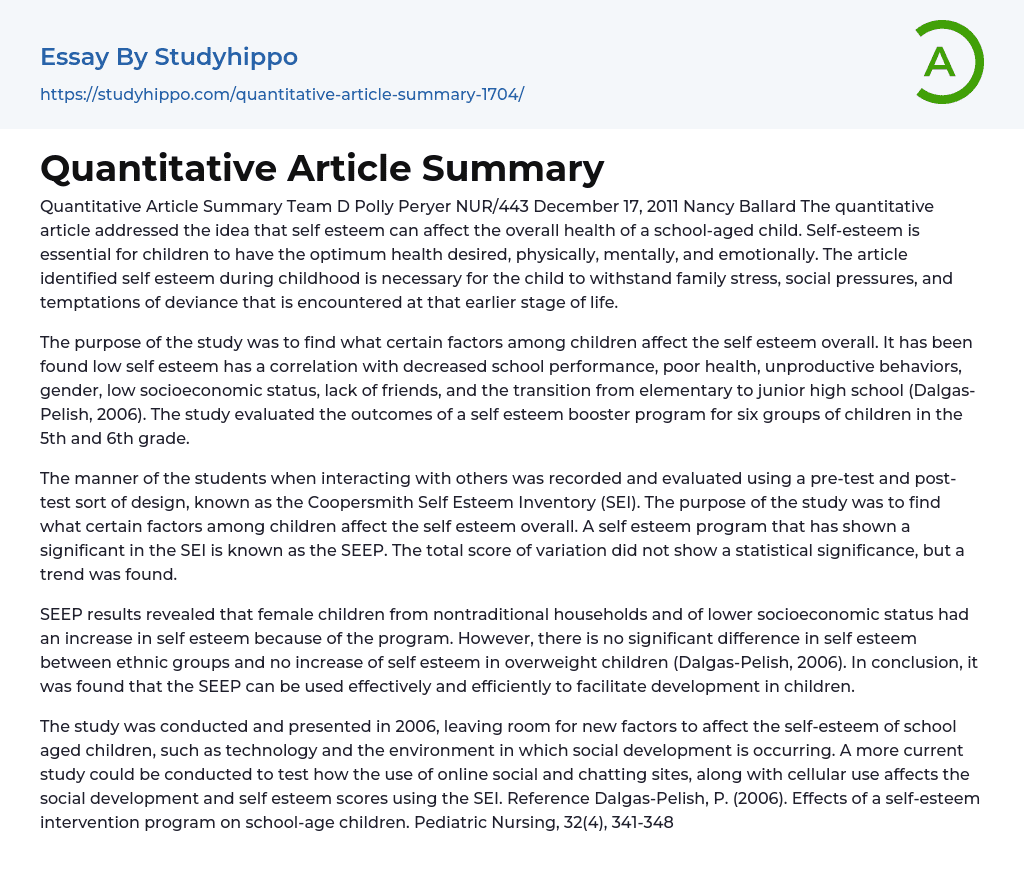The quantitative article addressed the idea that self esteem can affect the overall health of a school-aged child. Self-esteem is essential for children to have the optimum health desired, physically, mentally, and emotionally. The article identified self esteem during childhood is necessary for the child to withstand family stress, social pressures, and temptations of deviance that is encountered at that earlier stage of life.
The purpose of the study was to find what certain factors among children affect the self esteem overall. It has been found low self esteem has a correlation with decreased school performance, poor health, unproductive behaviors, gender, low socioeconomic status, lack of friends, and the transition from elementary to junior high school (Dalgas-Pelish, 2006). The study evaluated the outcomes of a self esteem booster program for six groups of c
...hildren in the 5th and 6th grade.
The manner of the students when interacting with others was recorded and evaluated using a pre-test and post-test sort of design, known as the Coopersmith Self Esteem Inventory (SEI). The purpose of the study was to find what certain factors among children affect the self esteem overall. A self esteem program that has shown a significant in the SEI is known as the SEEP. The total score of variation did not show a statistical significance, but a trend was found.
SEEP results revealed that female children from nontraditional households and of lower socioeconomic status had an increase in self esteem because of the program. However, there is no significant difference in self esteem between ethnic groups and no increase of self esteem in overweight children (Dalgas-Pelish, 2006). In conclusion, it was found that the SEEP can be used
effectively and efficiently to facilitate development in children.
The study was conducted and presented in 2006, leaving room for new factors to affect the self-esteem of school aged children, such as technology and the environment in which social development is occurring. A more current study could be conducted to test how the use of online social and chatting sites, along with cellular use affects the social development and self esteem scores using the SEI.
Reference
- Dalgas-Pelish, P. (2006). Effects of a self-esteem intervention program on school-age children. Pediatric Nursing, 32(4), 341-348
- Emergence essays
- Anxiety Disorder essays
- Post-traumatic Stress Disorder essays
- Nightclub essays
- Insanity essays
- Animals essays
- Charles Darwin essays
- Agriculture essays
- Archaeology essays
- Moon essays
- Space Exploration essays
- Sun essays
- Universe essays
- Birds essays
- Horse essays
- Bear essays
- Butterfly essays
- Cat essays
- Dolphin essays
- Monkey essays
- Tiger essays
- Whale essays
- Lion essays
- Elephant essays
- Mythology essays
- Time Travel essays
- Discovery essays
- Thomas Edison essays
- Linguistics essays
- Journal essays
- Chemistry essays
- Biology essays
- Physics essays
- Seismology essays
- Reaction Rate essays
- Roman Numerals essays
- Scientific Method essays
- Mineralogy essays
- Plate Tectonics essays
- Logic essays
- Genetics essays
- Albert einstein essays
- Stars essays
- Venus essays
- Mars essays
- Evolution essays
- Human Evolution essays
- Noam Chomsky essays
- Methodology essays
- Eli Whitney essays




